- Home
- Stephen E. Ambrose
Supreme Commander
Supreme Commander Read online
Stephen E. Ambrose
THE SUPREME COMMANDER
Stephen E. Ambrose wrote twenty books on military affairs and foreign policy. Early in his career he was an associate editor of The Eisenhower Papers, and he later went on to publish the definitive, three-part biography of Eisenhower, as well as many bestselling books of military history, including Band of Brothers and Undaunted Courage. He died in 2002.
Also by Stephen E. Ambrose
Halleck: Lincoln’s Chief of Staff (1962)
Upton and the Army (1964)
Duty, Honor, Country: A History of West Point (1966)
Eisenhower and Berlin, 1945: The Decision to Halt at the Elbe (1967)
Crazy Horse and Custer:
The Parallel Lives of Two American Warriors (1975)
Ike’s Spies: Eisenhower and the Espionage Establishment (1981)
Pegasus Bridge: June 6, 1944 (1985)
Nixon, Vol. 1: The Education of a Politician, 1913–1962 (1987)
Nixon, Vol. 2: The Triumph of a Politician, 1962–1972 (1989)
Eisenhower: Soldier and President (1990)
Nixon, Vol. 3: Ruin and Recovery, 1973–1990 (1991)
Band of Brothers: E Company, 506th Regiment, 101st Airborne from Normandy to Hitler’s Eagle’s Nest (1992)
D-Day: June 6, 1944—The Climactic Battle of World War II (1994)
Undaunted Courage: Meriwether Lewis, Thomas Jefferson, and the Opening of the American West (1996)
Citizen Soldiers: The U.S. Army from the Normandy Beaches to the Bulge to the Surrender of Germany—June 7, 1944–May 7, 1945 (1997)
Americans at War (1997)
The Victors: Eisenhower and His Boys: The Men of World War II (1998)
Comrades: Brothers, Fathers, Heroes, Sons, Pals (1999)
Nothing Like It in the World: The Men Who Built the Transcontinental Railroad, 1863–1869 (2000)
The Wild Blue:
The Men and Boys Who Flew the B-24s Over Germany (2001)
To America: Personal Reflections of an Historian (2002)
This Vast Land:
A Young Man’s Journal of the Lewis and Clark Expedition (2003)
FIRST ANCHOR BOOKS EDITION, JANUARY 2012
Copyright © 1969, 1970 by Stephen E. Ambrose
All rights reserved. Published in the United States by Anchor Books, a division of Random House, Inc., New York, and in Canada by Random House of Canada Limited, Toronto. Originally published in hardcover in the United States by Doubleday, Inc., New York, in 1970.
Anchor Books and colophon are registered trademarks of Random House, Inc.
Portions of this work were first published in the following periodicals: American History Illustrated, “The Big Appointment” and “Eisenhower’s Greatest Decision,” copyright © 1968, 1969 by Historical Times, Inc., respectively; The National Observer, “Nailing Down D-Day Details”; American Heritage, “A Fateful Friendship,” copyright © 1969 by American Heritage Publishing Co., Inc.
The maps in this volume appeared in Crusade in Europe by
Dwight D. Eisenhower, copyright © 1948 by Doubleday & Company, Inc.
The Cataloging-in-Publication Data is on file at the Library of Congress.
eISBN: 978-0-307-94663-8
www.anchorbooks.com
Cover photograph: Hollandse Hoogte/Redux.
Cover design by Base Art Co.
v3.1
For Moira with love
Preface
This is the story of a soldier. It is told in his terms. I have attempted to describe General Eisenhower’s wartime service, his major decisions and activities, and the results from within his frame of reference. For the most part, I examine the alternatives as he saw them, seldom trying to suggest how things might have been done differently or what other approaches to problems were possible. What I have tried to do is to pull together the many facets of his service and to give some sense of the scope of his responsibilities.
This work does not attempt to analyze some basic questions. I do not pretend to deal with the political or moral aspects of the war; with few exceptions, Eisenhower did not try to set policy. He believed that his function was to carry out the policies created by his superiors. Even had Eisenhower not seen himself as an agent and tried to be more active in the formation of policy, it is unlikely that he would have changed much in the basic approach taken by the British and American governments in fighting the war, for he accepted—indeed, heartily endorsed—the mostly unquestioned assumptions held by the governments. As he saw it, he was given a job to do and he did it. How he did it is the subject of this work.
My hope is that it conveys some sense of the magnitude of the task Eisenhower undertook and met, a feeling for the extraordinary charm and deep integrity of the man, a conception of the way in which he operated, a recognition of the manner in which he weighed alternatives, made decisions, and saw to the enforcement of his orders, and some understanding as to the way his decisions affected the outcome of the war.
My debts are deep. Dr. Alfred D. Chandler, Jr., editor of the Eisenhower Papers, was a constant source of encouragement. Dr. Forrest Pogue read the entire manuscript, patiently helped me to avoid pitfalls, and generously gave of his great knowledge of the American high command in World War II. Dr. Robert A. Divine read the chapters dealing with Eisenhower’s role in Franco-American relations and provided many useful suggestions. Sir Ian Jacob went through all the chapters, a laborious task in itself, and added to his labors by giving me not only general criticism but also comments drawn from his personal experience, which were always illuminating. In addition, he was kind enough to lend me his personal diary, on which I drew heavily.
The staff of the Eisenhower Project at the Johns Hopkins University, especially Miss Joyce Daidakis and Miss Nellie Wahbe, kept me at the typewriter when I wanted to go duck hunting. Mr. Edwin Alan Thompson, the chief researcher for the Project, provided me with information and documents from sources known only to him. Mrs. Elizabeth Smith was more than an outstanding typist; she was a stern critic and is a good friend. Mrs. Lois Sacks and Mrs. Jean Sample assisted by, among other things, making the work seem worth the effort. I only wish I could properly express my thanks to each member of the staff.
I doubt very much that I could have completed this work without the aid of the staff of the Eisenhower Project; I know that I would not have finished without the support of Joseph P. Hobbs, the assistant editor of the Eisenhower Papers. He read and minutely criticized the first draft of each chapter, which more often than not led to a complete reorganization and revision of the chapter. His great knowledge of General Walter Bedell Smith, whose biography he is writing, and of the events and issues of World War II, was absolutely indispensable to me. Through hundreds of lunch hours and thousands of coffee breaks, he has given me the benefit of his insights and discoveries. I hope that someday I can find a way to repay him.
The dedication is to the one who makes it possible for me to undertake and complete a task. More important, she makes it all worthwhile.
Stephen E. Ambrose
Naval War College
Newport, Rhode Island
December 1969
Contents
Cover
About the Author
Other Books by This Author
Title Page
Copyright
Dedication
Preface
Maps: (By Rafael Palacios)
BOOK ONE
The First Two Years
PART I: WASHINGTON TO LONDON
[December 1941—June 1942]
Chapter 1: DEBACLE IN THE PACIFIC
Chapter 2: ESTABLISHING THE ORGANIZATION AND THE STRATEGY
Chapter 3: “BOLERO”: THE BUILD-UP IN ENG
LAND
PART II: LONDON TO GIBRALTAR
[June 1942—December 1942]
Chapter 4: THE THEATER COMMANDER
Chapter 5: THE BLACKEST DAY IN HISTORY
Chapter 6: THE TRANSATLANTIC ESSAY CONTEST
Chapter 7: PREPARING THE “TORCH”
Chapter 8: THE INVASION OF NORTH AFRICA
Chapter 9: THE DARLAN DEAL
Chapter 10: THE FIRST CAMPAIGN
PART III: OPENING THE MEDITERRANEAN
[January 1943—July 1943]
Chapter 11: CONFERENCE AT CASABLANCA
Chapter 12: KASSERINE PASS
Chapter 13: CLIMAX IN TUNISIA
Chapter 14: THE LOCAL POLITICAL MESS
Chapter 15: PREPARING “HUSKY”: MARCH—JULY 1943
Chapter 16: SICILY
PART IV: THE ITALIAN CAMPAIGN
[July 1943—December 1943]
Chapter 17: THE BEGINNING
Chapter 18: THE ITALIAN SURRENDER NEGOTIATIONS
Chapter 19: SALERNO
Chapter 20: STALEMATE IN ITALY
Chapter 21: THE BIG APPOINTMENT
Chapter 22: PREPARING FOR “OVERLORD”
Chapter 23: EPILOGUE: EISENHOWER ON THE EVE OF “OVERLORD”
BOOK TWO
Supreme Commander, Allied Expeditionary Force
PART I: THE PREPARATION
[January 1944—June 1944]
Chapter 1: “WE CANNOT AFFORD TO FAIL”
Chapter 2: THE “ANVIL” DEBATE
Chapter 3: THE TRANSPORTATION PLAN
Chapter 4: LE GRAND CHARLES AND OTHER POLITICAL PROBLEMS
Chapter 5: WORRIES OF A COMMANDER
PART II: THE INVASION
[June 1944—September 1944]
Chapter 6: THE SIXTH OF JUNE
Chapter 7: STALEMATE
Chapter 8: “CROSSBOW” AND “ANVIL” AGAIN
Chapter 9: BREAKOUT
Chapter 10: THE LIBERATION OF PARTS
Chapter 11: CROSSING THE SEINE AND A NEW COMMAND STRUCTURE
PART III: THE GERMAN RECOVERY
[September 1944—December 1944]
Chapter 12: ARNHEM AND ANTWERP
Chapter 13: SINGLE THRUST VS. BROAD FRONT IN RETROSPECT
Chapter 14: A DREARY AUTUMN
Chapter 15: THE BULGE
Chapter 16: SHOWDOWN WITH MONTGOMERY, DE GAULLE, AND BROOKE
Chapter 17: DUTIES AND RESPONSIBILITIES
PART IV: THE LAST CAMPAIGN
[January 1945—May 1945]
Chapter 18: THE RHINELAND BATTLES
Chapter 19: CROSSING THE RHINE AND A CHANGE IN PLAN
Chapter 20: CONTROVERSY WITH THE BRITISH
Chapter 21: VICTORY
GLOSSARY
NOTE
Maps
(By Rafael Palacios)
ALLIED MEDITERRANEAN CAMPAIGNS—following this page
OVERLORD FORECAST—following this page
LIBERATION OF FRANCE—following this page
OVERRUNNING GERMANY—following this page
BOOK ONE
The First Two Years
Part I
WASHINGTON TO LONDON
[December 1941–June 1942]
ON December 12, 1941, five days after Pearl Harbor, newly promoted Brigadier General Dwight Eisenhower, chief of staff of the U. S. Third Army in San Antonio, Texas, received a telephone call from the War Department in Washington. Colonel Walter Bedell Smith, Secretary of the General Staff, asked, “Is that you, Ike?” “Yes,” Eisenhower replied. “The Chief says for you to hop a plane and get up here right away,” Smith ordered. “Tell your boss that formal orders will come through later.”
Eisenhower had no idea what the War Department wanted with him, how long he would be in Washington, or what his duties would be. But “the Chief” was Army Chief of Staff George C. Marshall, so Eisenhower asked no questions. He abandoned his plans to visit his son at West Point at Christmastime, packed a single bag, and boarded the next airplane leaving San Antonio for Washington. Mechanical failure forced the craft down at Dallas. Eisenhower shifted over to a train, which got him into Union Station, Washington, on December 14. He immediately reported to Marshall, whose office was in the old Munitions Building.1
The two men had met twice before. In 1930, when Eisenhower was working with the American Battle Monuments Commission in Washington, they had talked. Marshall was so impressed with Eisenhower that he asked the young major to join his staff at the Infantry School at Fort Benning. Another assignment made it impossible for Eisenhower to accept, and they had only one additional brief meeting before 1941.2
Marshall had ordered Eisenhower to Washington because he wanted him on the War Plans Division of the General Staff to handle the Far East, especially the Philippines, where Eisenhower had served under General Douglas MacArthur for four and a half years. The Chief of Staff wasted no time. He quickly outlined the situation in the Pacific. The Japanese attack on Pearl Harbor had rendered the Navy impotent for some months to come. Although the aircraft carriers were intact they had few supporting vessels. The garrison in Hawaii was weak and an amphibious Japanese landing there was a possibility. The islands had to be strengthened. In the Philippines the ground force consisted primarily of Filipinos and Eisenhower knew full well that their training had not proceeded far enough to make them capable of stopping the Japanese. Marshall had increased the air strength during 1941, giving MacArthur 37 B-17s and 220 fighters, but they had been hit at Clark Field. Marshall did not know the exact extent of the damage but, given the Japanese successes in other areas, he feared the worst. There were serious supply shortages, the Navy was already indicating that it was unwilling to try to break the increasingly tight enemy blockade and was going to write the Philippines off, and the Japanese intended to overrun the islands as soon as possible.
Marshall took about twenty minutes to describe the situation. Suddenly he looked straight at Eisenhower and quietly demanded, “What should be our general line of action?”
Eisenhower was startled. He had just arrived, had not unpacked his bag, knew little more than what he had read in the newspapers and what Marshall had just told him, was not up to date on the war plans for the Pacific, and had no staff to help him prepare a general policy line. Still, he immediately recognized that the assignment was important, not so much because the Chief of Staff had decided to hand over Pacific strategy to a new brigadier general (Marshall, as Eisenhower probably guessed, had already decided upon his policy), but as a personal test. After a second or two of hesitation, Eisenhower asked, “Give me a few hours.”
“All right,” Marshall replied. His Army had just suffered a humiliating defeat, bad news continued to come in from around the globe, he had problems with expansion, training, supply, strategy, and a hundred other things, and was not going to waste any time. Marshall wanted to know who could do the job for him and who could not, and he wanted to know it immediately. Eisenhower’s answer would tell him whether this young general was up to the challenge.3
Eisenhower left Marshall’s office and went to a desk that had been assigned to him in the War Plans Division. In preparing his answer he had little to work with, for the United States had no specific plan for the war then going on in the Pacific. The official strategy was embodied in RAINBOW 5, a world-wide program which called for a major effort against the European Axis powers and a defensive effort in the Pacific. Marshall was determined to stick with RAINBOW 5, despite already mounting pressure to turn the full fury of American might, such as it was in December 1941, against the Japanese. The trouble was that RAINBOW 5 contained no settled solution for the defeat of Japan and was based on assumptions that were already crumbling in the face of the Japanese onslaught.
The general idea had been that the Philippines would hold out long enough to allow the fleet to advance across the central Pacific through the Marshalls and the Carolines to save the islands, while the British, Dutch, and Chinese forces contained the Japanese in the Southwest Pacific. B
ut already, a week after the conflict began, the plans were out of date. Except for its carriers, the United States had no fleet. It was apparent that the Philippines would not be able to hold out, nor would the colonial powers south of the Philippines. Willy-nilly the Americans were on the defense in the Pacific; the problem was whether to abandon the garrison in the Philippines, since any material sent there would inevitably wind up in Japanese hands, and build a base to the south, or to make an effort to hold the islands, or to try a combination of both. In addition, agreements had to be reached with the other governments fighting the Japanese.
Eisenhower decided that, for morale purposes, the Philippines could not be abandoned. The War Department would have to make every effort to reinforce the garrison. Sticking a sheet of yellow tissue paper in his typewriter, he tapped out with one finger “Steps to Be Taken.” The first requirement was to “build up in Australia a base of operations from which supplies and personnel (air and ground types) can be moved into the Philippines. Speed is essential.” This program would not only give heart to the American people and the soldiers in the Philippines but would provide the beginnings of a long-range counteroffensive. Australia appeared fairly safe; with its good harbors, British Commonwealth connections, and English-speaking people, it was the obvious place to build up the base of operations for the Pacific war.
Eisenhower’s next paragraph was a simple sentence: “Influence Russia to enter the war.” There were great potential benefits. Russian entry would tie down Japanese troops in Manchuria and provide the United States with airfields from which American bombers could hit the home islands of Japan.
For immediate action, Eisenhower recommended sending a carrier with Army pursuit planes, pilots, ammunition, and bombs from San Diego to Australia, and—if possible—saving time by sending a carrier directly from Hawaii to Australia. Another recommendation was to move planes and crews to Australia from the West Coast by the fastest available commercial vessels. Finally, Eisenhower wanted to ferry the planes collected in Australia to the Philippines.4

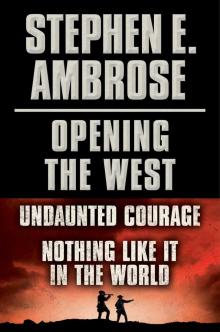 Undaunted Courage
Undaunted Courage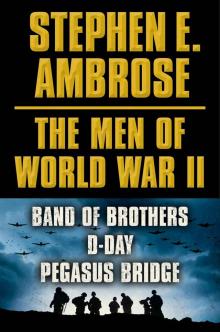 The Victors: Eisenhower and His Boys
The Victors: Eisenhower and His Boys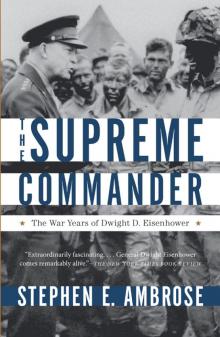 The Supreme Commander
The Supreme Commander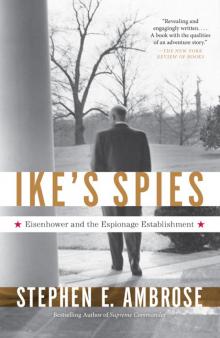 Ike's Spies: Eisenhower and the Espionage Establishment
Ike's Spies: Eisenhower and the Espionage Establishment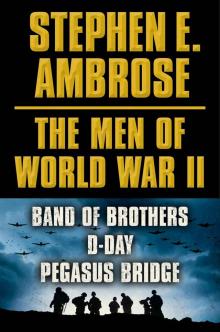 The Men of World War II
The Men of World War II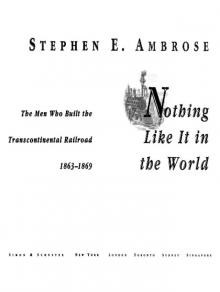 Nothing Like It in the World The Men Who Built the Transcontinental Railroad 1863-1869
Nothing Like It in the World The Men Who Built the Transcontinental Railroad 1863-1869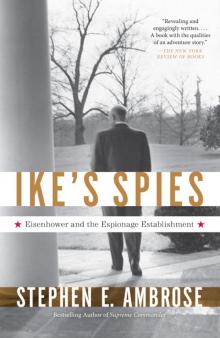 Ike's Spies
Ike's Spies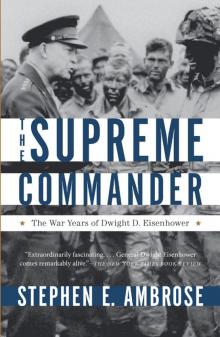 Supreme Commander
Supreme Commander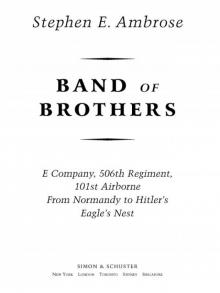 Band of Brothers
Band of Brothers